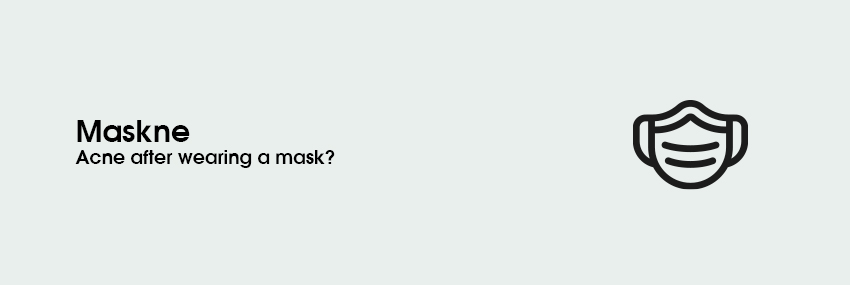Maskne has become a common condition in this time. This type of acne makes pimples appear due to the use of face masks and can become a burden for our daily lives. Do you want to get rid of it? Do you want to know how to prevent it? Take a look at this guide!
We will remember this year for many things, but one of them will undoubtedly be the coronavirus and how we began to become familiar with the use of masks, which have become part of our daily lives. Face masks are a fundamental tool when it comes to keeping ourselves and those around us protected, and although their use entails certain discomforts, it is essential. One of the most common disadvantages of using masks is the appearance of pimples in the area they cover, which is popularly known as maskne. Do you want to know what it is exactly and how to avoid it and improve it? Keep reading!
1. MASKNE: WHY DO YOU GET PIMPLES WHEN USING A MASK?
If you have read my guide on acne, you will remember that it is a very common skin problem and that it occurs as a result of several factors (usually jointly), such as excessive sebum production, the proliferation of keratinocytes, alterations of the immune system and the increased presence of Cutibacterium acnes in the microbiota of the skin. In addition to this, there are other factors that also affect the appearance of acne, some of them being diet, stress and hormonal alterations.
Can using a mask cause acne breakouts? Yes, it is known as acne mechanica, which has popularly been named maskne. This condition is not exclusive to the use of masks, it also occurs as a result of the rubbing of certain garments (such as sports or surgical equipment) against our skin.
Those pimples that appear in the area that we cover with the mask (nose, cheeks and chin) arise as a consequence of several perfectly visible causes that lead to inflammation in the area and the excessive production of sebum and keratinocytes. The first of the causes is the most obvious: the friction of the mask itself against our skin. In addition to this, a warm and moist environment is produced inside the mask, favoring the proliferation of bacteria and irritation. Likewise, if we do not change the mask as often as we should (a maximum of 4 hours for hygienic and surgical masks), it is more likely that it will degrade and that, in addition to accumulated sweat and saliva, other microorganisms will appear that go to contribute to the imbalance of our skin barrier. All these causes, added to the possible predisposition that we may have to suffer from acne (as well as the possible concurrence of other hormonal factors and those derived from the lifestyle that I mentioned before) can cause pimples to appear in this area and, like many people, make us suffer from maskne.
Although I indicated it at the beginning of the article, I want to insist on the importance of always using a mask (and doing it correctly), always in conjunction with the practice of social distance, which is essential to get us out of this situation. If we use hygienic or surgical masks we have to change them, at most, every 4 hours. In addition, we must be very careful when handling them and wash our hands frequently to try to reduce, as much as possible, our exposure to the coronavirus.
Now that you know why pimples appear as a result of using a face mask, you surely want to know how to prevent them and how to make them disappear, right? Keep reading, then!
2. HOW TO PREVENT AND TREAT MASKNE.
You already know that maintaining a good basic routine of cleansing, moisturizing and sun protection is essential. With it, you keep your skin barrier protected and thus you can start treating the issues that concern you the most (such as spots and wrinkles, as well as acne itself).
When it comes to preventing the appearance of this type of pimples there are a series of basic measures that we can adopt and that are very effective:
- As I indicated before, use the mask correctly, replacing it whenever necessary and washing it after each use (if it is a reusable mask).
- Handle the mask as little as necessary. This will reduce friction and therefore your skin is less likely to be irritated. Remember that you should wash your hands after handling it.
- Keep a healthy lifestyle. As I mentioned before, acne is multifactorial, so by reducing stress, eating in a balanced way and exercising moderately, we reduce the probability that it appears as a result of an unhealthy lifestyle.
- Maintain adequate basic skincare routines. Use mild cleansers, moisturize your skin properly, and don’t skip sunscreen.
- If necessary, reduce the use of actives in your skincare routines. Since some of the more powerful actives (such as retinoids, exfoliating acids, or vitamin C) are potentially irritating, reducing their use also minimizes the possibility that your skin will be irritated as a result of the use of the mask.
Of course, although we strive to comply with all these measures, sometimes our skin can be a bit more rebellious than we would like and pimples can appear anyway. In addition to following the instructions that I included in my guide on acne and my guide on irritation, we can carry out other measures that will help us reduce acne and restore balance to our skin barrier:
- Stay home as much as possible. Social distancing is essential to win the battle against coronavirus. In addition, by staying at home you do not need to wear the mask and, therefore, you will allow your skin to recover so that, little by little, those pimples disappear.
- Wash your face properly. A very common mistake is to think that, if we have pimples, we need to get rid of them through a deep and very aggressive cleaning. However, by doing this we only manage to unbalance our skin even more, which will continue to produce too much sebum and enter a vicious cycle. Instead, use gentle cleansers in your morning and evening routines.
- Moisturize your skin properly. It is not always easy to find a moisturizer that meets the needs of our skin. However, since the area covered by the mask suffers more from contact with it, we must deeply moisturize it. I have been using these Paula’s Choice moisturizers for a few months, they are very nourishing, and I am delighted with the result.
- Use cosmetics with ingredients that are anti-inflammatory and beneficial to your skin barrier. Some of the ingredients that can help you the most to reduce irritation are ceramides, fatty acids or cholesterol.
- When treating pimples themselves, you can use certain ingredients that help to rebalance the production of sebum and keratin, such as niacinamide, retinoids or certain exfoliating acids, finding the balance between treat the problem without further irritating the skin.
- Use a pimple patch. Pimple patches can help you avoid further irritation by protecting your face from the continued friction of the mask. I especially like the ByWishtrend Clear Skin Shield Patch, available on Wishtrend and on Yesstyle.
Although maskne can be very annoying, we must be aware that we can treat it properly and that, after all, it is a lesser evil compared to what COVID-19 implies. In any case, I hope that with the advice you have found in this article you now know how to better deal with maskne to help your skin regain its balance.
Have you suffered from maskne? How do you deal with it? Is there a cosmetic that has especially helped you? Tell me in the comment section!
If you liked this article and want to learn how to take better care of your skin, you will surely be interested in reading these other articles:
Do you want to learn to take better care of your skin? You can see an index of all my informative posts here.*I have received some of these products as PR | Read more about my transparency code.
● Follow me on Instagram, Facebook, TikTok and Pinterest.
● Share, comment and like my posts on social media.
● Shop through my links to help me keep up with this blog.

I’m Nacho and I’m passionate about skincare. I really enjoy learning and sharing my knowledge about skincare and I read scientific papers so you don’t have to. I want to break stereotypes because I believe skincare has no gender: skin is skin.


